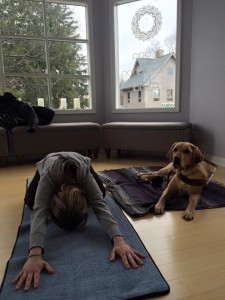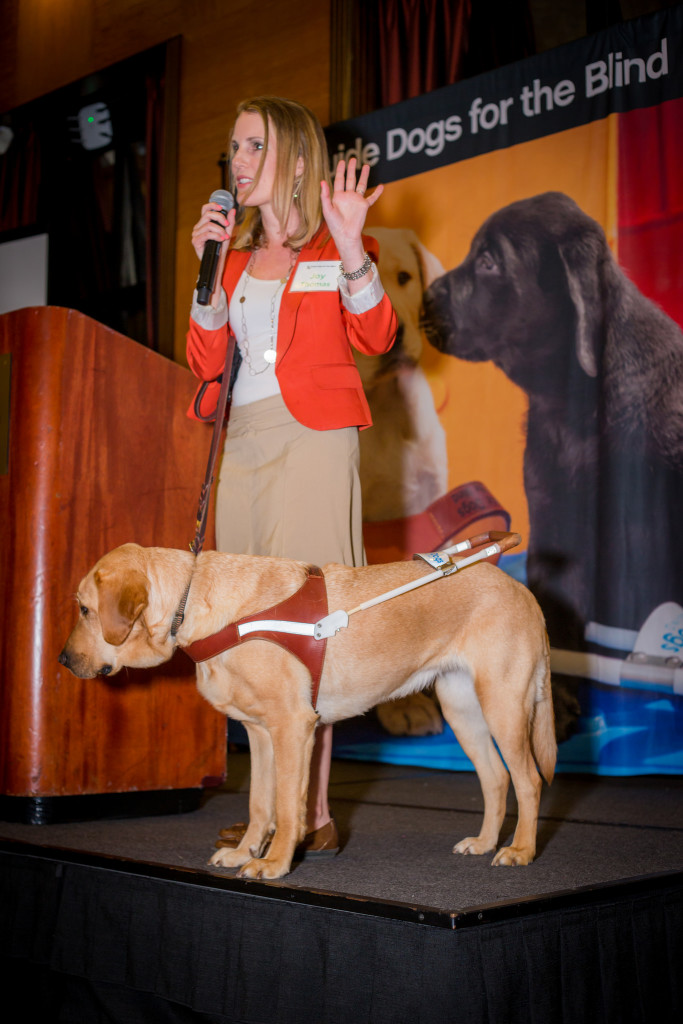 If you or a loved one has a disability, you’ve probably encountered many wonderful, helpful people. You’ve probably also encountered some, shall, we say, overly helpful folks?
If you or a loved one has a disability, you’ve probably encountered many wonderful, helpful people. You’ve probably also encountered some, shall, we say, overly helpful folks?
Being legally blind, I usually have no shortage of helpers while out in public with my cane or guide dog. “Can I get that door for you?” “Can I grab some silverware from the buffet for you?” “May I assist you with reading that menu?”
Most of these are what I’d consider helpful gestures, and I sometimes take people up on their offers if my hands are full juggling children and leashes, and other times I politely decline the offer, and all is well. Every once in awhile, however, I find myself in a code red, help-aholic situation.
Like a couple weeks ago at yoga. I was attending a class with an absolutely amazing teacher at a studio that I practice at regularly. I arrived two minutes before class was starting, which really isn’t ideal when you have a guide dog to get situated, a mat to roll out and yoga props to gather. To make matters more challenging, the tiny room was packed with people.
Upon our arrival, everyone began maneuvering themselves around to make room for us, and a couple of my classmates who know me well offered to grab my props while I got situated.
“Oh my gosh, thank you!” I breathed a sigh of relief. Just then a voice popped up next to me.
“Hi, I’m Marcy and I went ahead and folded your blanket and put your water bottle at 2 o’clock. I also took your dog’s leash and tucked it behind her because I didn’t want it to get in your way.”
“Oh thanks. Nice to meet you.” I stammered, slightly taken aback that she had touched my things without asking. I try to give people the benefit of the doubt, however, so maybe she just saw others being helpful and thought she’d do the same. I got into Child’s Pose and hoped for the best.
“Today we’re going to start with a gentle twist,” stated Greg, our instructor, “Begin by crossing your right leg over…..”
“Here, like this!” Marcy interrupted loudly, touching my right leg. “Put that leg over the other one and wrap it around.”
Twists usually are confusing for me (so much leg criss-crossing, and I don’t listen very well for a blind chic!), but I usually eventually figure it out. Apparently I was not getting into the pose fast enough for Marcy.
I quickly got into the correct twist position, but then missed Greg’s next instruction while Marcy was loudly instructing me, and I couldn’t see what pose Greg was moving into.
“We are on all fours now!” Marcy did not excel at whispering.
Oh, Table Pose. I knew that one. “Now we’re going to go into a gentle downward dog,” Greg continued. Oh good, I know how to do that well, but I usually like to do a cat/cow or two before getting into my down dog. Greg always encourages his students to listen to what their bodies are telling them to do, so I make slight variations and add in poses at times.
“Downward dog is where you….” Marcy began. She was not okay with variations.
“Yeah I know,” I whispered, trying to get back into my yoga zone as I moved fluidly into my down-dog. There, now Marcy could see that I knew what I was doing.
But her little “helpful” interjections continued. I found myself trying to speed quickly into each pose, for fear that Marcy would loudly offer her assistance if I didn’t high-tail it into Warrior I. Occasionally, instructors come around and readjust students, and I really don’t mind when they adjust me or give reminders. They are, after all, the instructors, and most do it in a way that still honors the individual practice. But Marcy was not only not honoring my practice….she was missing out on her own.
“Remember to play with these poses and have fun,” Greg told our class gently, “It’s your own, individual practice, so try to go inward and sense what your body needs.”
Yo, Marcy, he’s talking to you.
But Marcy was too busy observing my Wounded Warrior to listen to Greg’s gentle reminder.
I, too, was having trouble focusing. All I could think about was how pushy Marcy was with her help. And the feelings it brought up were very familiar to me. It didn’t feel like Marcy’s help was about me at all. The whole thing felt like it was very much about her need to be a helper.
Marcy had a need to be needed, and I was filling that need perfectly.
I’d like to say that I came up with some catch-all, perfect phrase to get Marcy off my case (or, more specifically, off my mat), but I couldn’t quite stop in the middle of class to hold a help-aholic intervention. If I was going to enjoy the rest of my yoga class, I knew I needed to do what the mighty yogis teach: Be mindful and ignore the chatter. Not just Marcy’s outward chatter, but the conversation going on in my mind about Marcy and how annoyingly helpful she was.
I began to listen only to the calming music playing through Greg’s iPod. I closed my eyes and listened to his instructions, and when Marcy would start doing her thing, I simply focused entirely on my breath and tuned her out. I didn’t whisper thank you. Nor did I whisper shut up. I just inhaled and exhaled. And you know what? After awhile, I didn’t have to ignore anything because Marcy had ceased her chatter.
I think there is a time to confront and be straightforward with people. But I also think there is a time to be quiet and remember that their issue with over-helping has nothing to do with you. It’s about them, and sometimes you need to allow them the space to figure it out on their own. After all, isn’t that what you want from them?
Thank you, Marcy, for teaching me an important lesson. Namasté.








